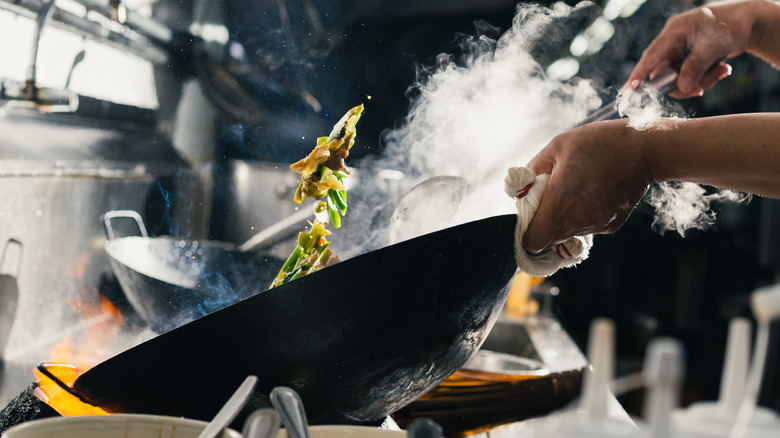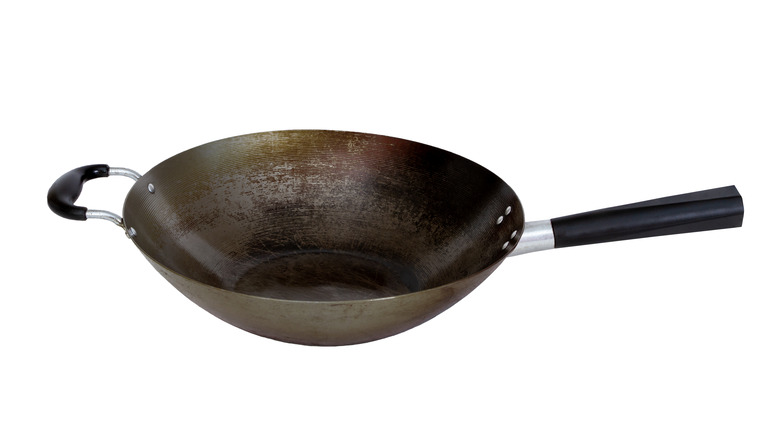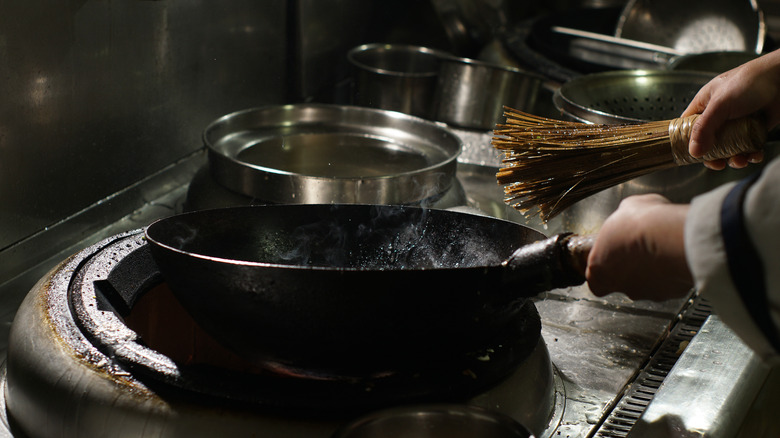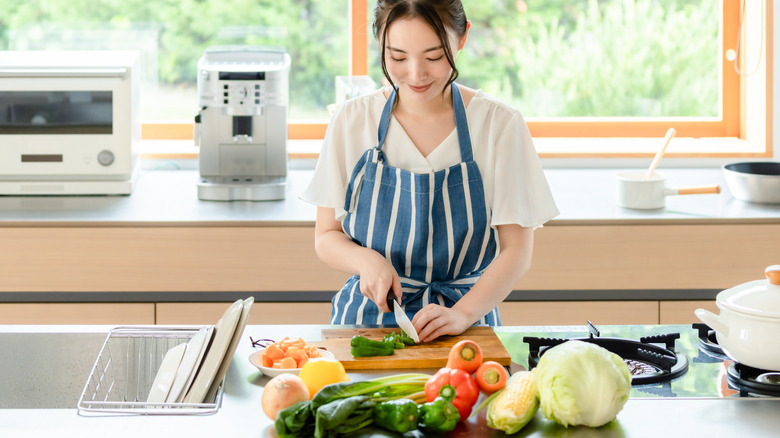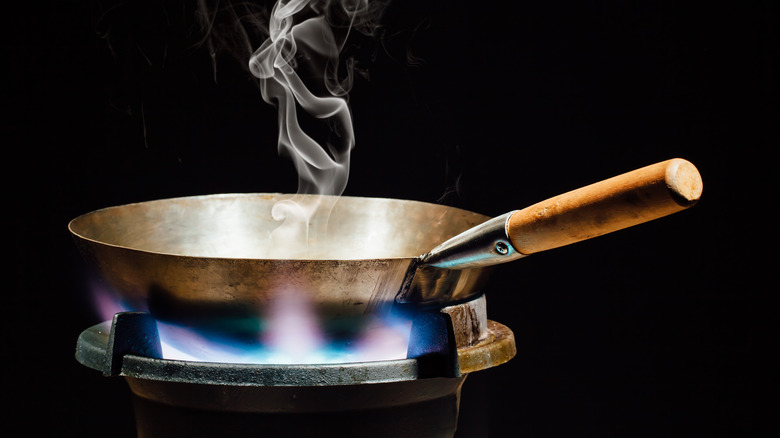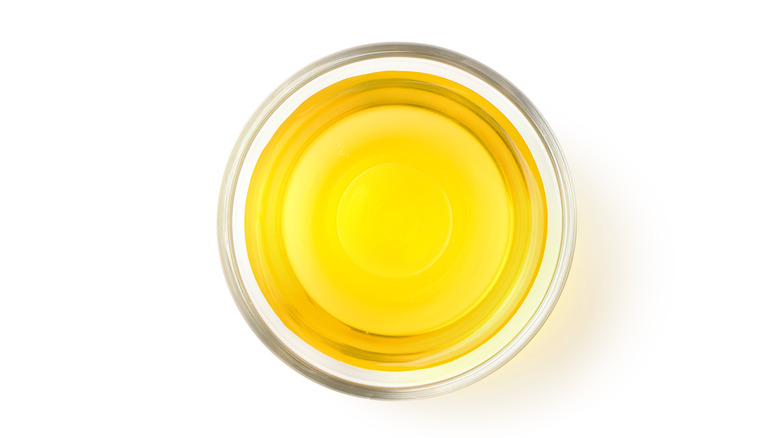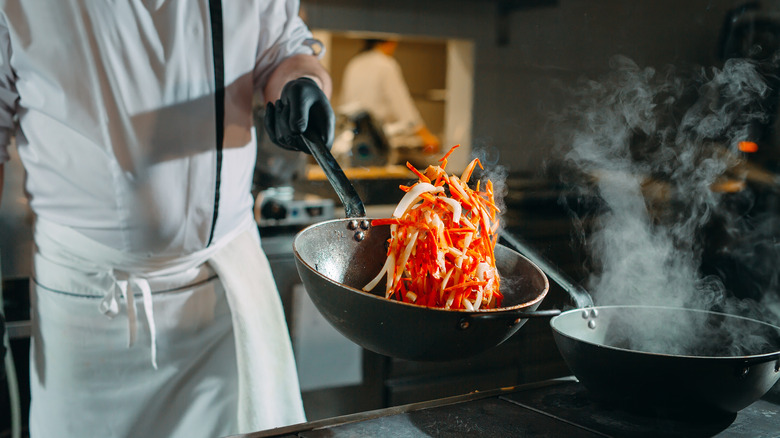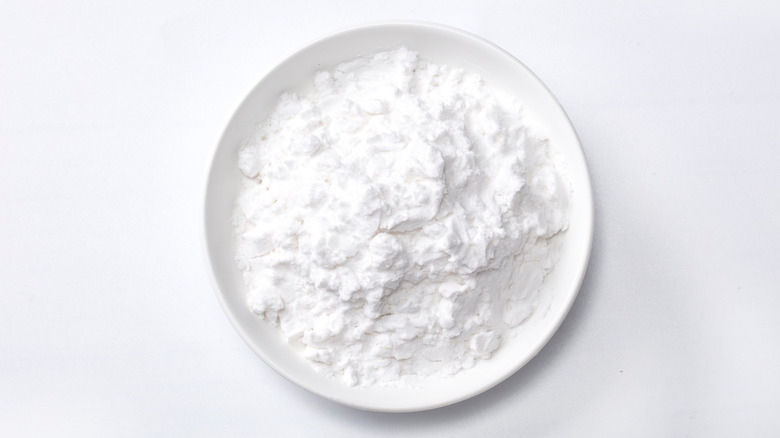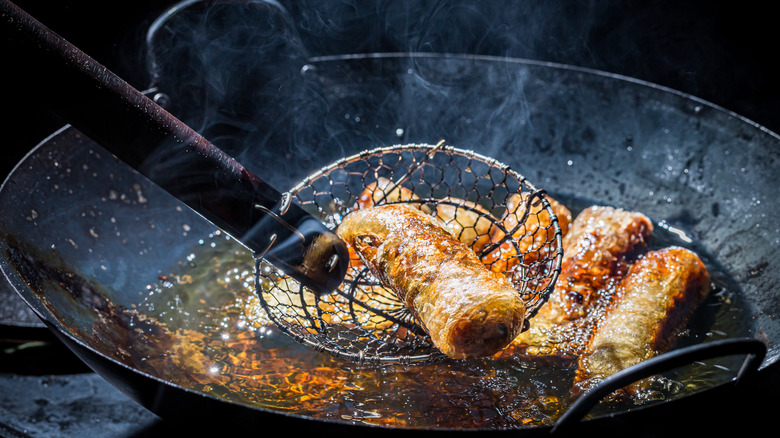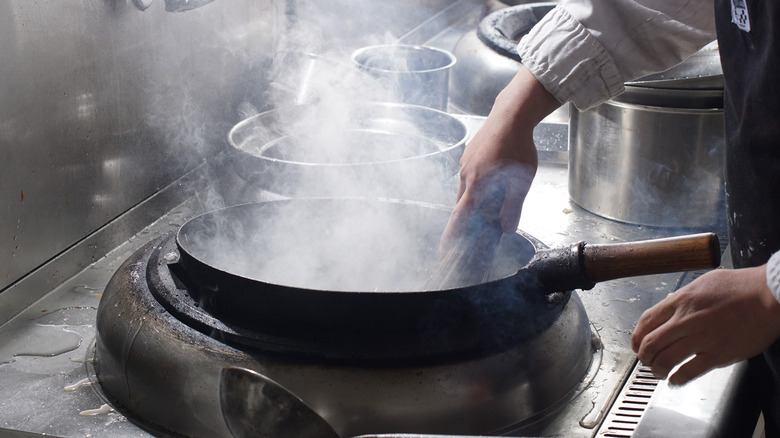Tips You Need When Cooking With A Wok
A large cooking pan with a curved, concave shape, the wok is a pillar of Asian cooking. Invented in China around 3,000 years ago, the wok is prized for its unique cooking abilities (via Encyclopedia Britannica). A hallmark of this Chinese cookware is wok hei, translated from Cantonese as "wok energy" or "wok breath," according to the New York Times. When ingredients are properly stir-fried in the cooking vessel, the resulting flavors should be infused with a smoky, slightly caramelized note. But besides stir-frying, woks can be used for a variety of cooking methods like steaming or deep-frying, transcending the wok beyond your average sauté pan.
Because of the endless culinary uses, a wok is essential for anyone looking to perfect their cooking skills. Of course, this also means there are plenty of tips, techniques, and tricks to master. Wok cooking is a lot more complicated than simply throwing ingredients into a pan and hoping for the best, and to help, we've curated the top 10 tips you'll need to master this diverse cooking tool.
Buy the right wok
The first thing to master before you even start cooking with a wok is to figure out the right one to buy. One of the most important things to pay attention to is the design of the wok itself. Is the wok flat-bottomed or round? Round-bottomed woks are better suited for gas stoves, while a flat-bottomed wok is ideal for an electric stove, Chinese food expert Fuchsia Dunlop explained to First We Feast.
Woks are also made from different types of material, including nonstick or Teflon-coated, cast iron, carbon steel, and stainless steel. Each of these types have their own advantages and disadvantages (via The Woks of Life). While easy to use and clean, nonstick woks will have their coating damaged by high-heat cooking. In comparison, stainless steel woks are good for high heat and lightweight, but because they heat quickly, ingredients can scorch rapidly, making it difficult to clean. Traditionally, woks are made from cast iron. This old-school design is time-tested and great for all kinds of cooking, however, cast iron is heavy and requires more maintenance and care than other materials.
Overall, we feel the best type of wok is carbon steel. A favorite of Dunlop's, carbon steel woks heat up and cool down quickly. Not only are they lightweight when compared to traditional cast iron, carbon steel is also great for high-heat cooking and will season overtime to produce a nonstick coating .
Always season your wok
While nonstick woks don't need to be seasoned, both carbon steel and cast iron woks will require this process. The main reason to season a wok is to produce a nonstick coating, called a patina, shares MasterClass, which will improve with continued cooking.
MasterClass explains there are several key steps to this process. To start the wok seasoning process, you first need to wash the wok and then dry it completely. Then, preheat it over a burner until it's smoking (be sure to open a window and turn on the exhaust fan for this). To tell if your wok is hot enough, sprinkle it with a little water: If the water instantly evaporates, its sufficiently hot. If not, return the wok to the heat and try again.
After your wok is properly heated, let it cool before adding a layer of oil (one with a high smoke point, such as vegetable or canola), coating it thoroughly. Then, reheat over the burner, rotating the wok so that every part starts to smoke again and turns a darker color. When this is complete, rinse with hot water and a wok brush. Finally, place the wok back on the burner to remove any remaining water before setting it aside to cool. Your wok is now seasoned and ready to be stored.
Prep and cut your ingredients uniformly
One of the key steps to cooking with a wok begins before any ingredients land in the vessel. Because stir-frying is done fast at high heat, MasterClass explains ingredients should be prepped, chopped, and sliced as uniformly as possible to ensure all the food cooks properly without getting scorched. There is nothing worse than having half your ingredients burnt to a crisp while the other half are still raw because you diced when you should have cubed.
When prepping your stir-fry ingredients, remember that they can be cut in a number of ways depending on your recipe. For instance, Serious Eats recommends dicing chicken breast for kung pao chicken, but thinly slicing the meat for chicken curry with green beans. For most meat cuts, remember to slice against the grain. This technique will have a noticeable effect on the tenderness of the meat.
Use a gas stove
Because cooking with a wok requires high heat, a gas burner is essential. According to Andrew Zimmern, this is because gas burners can be adjusted with more control compared to electric ones. The ability to control the heat to such a degree will lead to a much better finished product. However, you should know there is a big difference between a typical home kitchen gas burner and a professional restaurant burner. In Chinese restaurants, gas burners are intense, often featuring a 160k BTU burner that roars like a jet engine (via Serious Eats). The result of these burners are stir-fries filled with the classic wok hei flavors.
Of course, even in China, most home kitchens aren't equipped with such intense burners. In fact, many people in China consider this intense smoky taste to be a restaurant flavor profile, shares the New York Times. But if you're determined to achieve the intense heat of a professional Chinese restaurant kitchen, Serious Eats recommends purchasing a powerful outdoor gas burner that can be used in the backyard.
Use the right type of oil
While there are plenty of cooking oils out there, stir-fries cooked in a wok will require an oil with a high smoke point. So, what is smoke point? Simply put, the smoke point of oil is the temperature that the liquid starts to smoke (via MasterClass). There's a wide range of temperatures for this depending on which oil you're using, stretching from as low as 325 degrees Fahrenheit to 520 degrees. Essentially for cooking over high heat, what this means is if you use a low smoke point oil it will leave your food with a bitter and burnt flavor.
To avoid this, use oils with a high smoke point when cooking in a wok. Oils and fats like butter, extra virgin olive oil, and coconut oil should be avoided due to their low smoke point. Instead, use safflower, soybean, rice bran, or corn oil for stir-fries, which all have very high smoke points.
Don't overcrowd the wok
One of the biggest technique mistakes of stir-frying is overcrowding the wok. When there's too many ingredients in the wok, vegetables will become soggy instead of retaining that desirable crisp bite, explains MasterClass. According to Fuchsia Dunlop, too many ingredients in the wok will lead to subpar searing because there will be too much released liquid during cooking.
So, how do you avoid this? A great way is to cook your meat and vegetables in batches, thus retaining a good sear and maximum texture. Batch cooking is especially important for home cooks, since most lack the butane power of a restaurant gas burner mentioned above. In fact, Serious Eats recommends cooking with no more than eight ounces of ingredients at a time, allowing your wok or pan to reheat after each batch.
Toss your ingredients
Because speed is essential for stir-fries, a great technique to master is flipping the ingredients in your wok. According to Serious Eats, high heat will generate vaporized oil, wich combusts as the food gets tossed over the open flame. This is essential for producing that patented wok hei flavor of a stellar stir-fry.
While ladles or spatulas are important for cooking with a wok, mastering the toss is an critical technique for the best stir-fries. To accomplish this, first make sure that you have a wok with a single handle. (Some will have two small metal handles — these woks are mostly used for steaming or cooking extra large amounts of food, explains The Woks of Life.) To toss, Fuchsia Dunlop advises quickly pushing the wok away from your body before raising it and flipping the ingredients back towards you. Another great tool and technique recommended by Dunlop is the wok spatula. These long handled tools are especially useful for getting everything off the bottom of your wok while stir-frying.
Practice the art of velveting
To truly master stir-frying in a wok, one must understand the Chinese technique of velveting. Essentially, this method involves marinating a protein in corn starch and then briefly cooking it in hot oil or water before its added into the stir-fry (via Bon Appétit). The result of this crucial step produces incredibly tender meat along with a pleasantly thicker stir-fry sauce, the result of the corn starch marinade. If you ever wondered why proteins in Chinese restaurant stir-fries have such fantastic texture, velveting is the magic step.
To velvet your protein, the first step is to create a slurry. Bon Appétit recommends combining one pound of meat with a mixture of one tablespoon cornstarch, one tablespoon soy sauce, and one tablespoon vegetable or light sesame oil. Additionally, one can add aromatics like garlic or Shaoxing wine for flavor. For a thicker coating, some chefs also add an egg white. When the meat has been marinated, simply dunk it very quickly in hot oil; then you're ready to really get cooking.
Do more than just stir-fry
Despite the wok's excellence for stir-frying cooking, it's important to remember that woks are extremely versatile. Besides stir-frying, Serious Eats explains the cooking vessel can be used to steam, deep-fry, and braise.
To steam in a wok, you'll need steamer — preferably a bamboo one. To use, all you need to do is place your steamer directly into the wok and add enough water that the bottom is submerged (via The Woks of Life). Be sure to keep the water topped up, so the bottom doesn't burn.
In terms of braising, because of the wok's depth and size, ingredients can be slowly simmered to make dishes like mapo tofu or braised eggplant. The sloped design of the wok also allows you pour out a saucy dish quite easily.
Finally, there's deep-frying, which in many ways, the wok is better at than classic cast iron or Dutch ovens. The reason? The wok's broad, sloped sides allow you to fry with less oil, as well as catch a lot of the splattering, making less of a mess.
Take care of your wok
When properly cared for, a good carbon steel or cast iron wok will last a long time. As mentioned above, the first step is making sure it's properly seasoned. After that, wok maintenance is all about cleaning everything the correct way. While some people avoid using soup, it's not a hard rule, says The Woks of Life. After you wok has been washed, be sure to dry it with a towel and reheat on the stove to remove all the moisture, which will keep it from rusting. Last, lightly coat the interior of your wok with some oil. Over time, a carbon steel wok will slowly turn from silver to dark black — don't panic! This patina is perfectly normal and the sign of well-used wok.
Another important aspect of wok maintenance is to pay attention to the ingredients being cooked, as this will directly effect the cleaning process. This is especially relevant for dishes with high levels of acidity (The Woks of Life names vinegar as an example). For foods with high acidity, clean the wok immediately after cooking as the acid will damage the coating if unattended. If you cooked something with a strong-flavor, which tend to linger on the wok, you may want to wash it a few times before using again. Dishes featuring seafood or strong spices can impart their flavors in next dish if not fully removed. The last thing you want is yesterday's fish curry seeping into a light-tasting spinach stir-fry.
